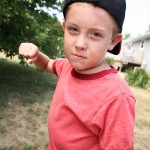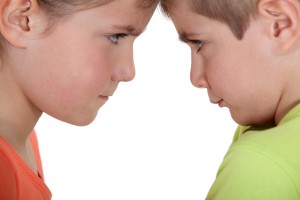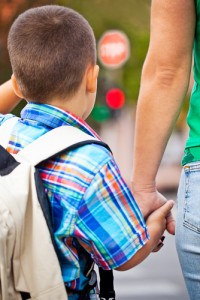
Clinicians and mental health researchers have long recognised that there is a link between traumatic experiences in childhood and symptoms of psychosis or non-clinical psychotic experiences presenting in adolescence or adulthood.
One type of traumatic experience is the experience of abuse, whether physical, emotional or social in nature. When it comes to bullying, any or all of these may be involved.
Whilst many researchers have noticed that there appears to be a relationship between experience of psychotic symptoms and experiences of bullying, very few longitudinal studies have been carried out to investigate this further. That is to say, very few studies have assessed whether or not someone is being bullied at one time point, and then followed them up years later to see whether that appears to have had an impact on their mental wellbeing at a later time in their lives. There are even fewer longitudinal studies lasting past five years in length and which also control for pre-existing difficulties – in fact, to date, there’s just one (Wolke et al, 2013).
Method
Wolke and colleagues used data from a bank of data previously collected from mothers and children involved in the Avon Longitudinal Study of Parents and Children (ALSPAC). The participants for ALSPAC are made up of families who were living in Avon and expecting a child in 1991-1992. Since this is a birth cohort (participants were only selected based on the birth date of the baby), it can be assumed to be a representative sample of families with young children throughout the UK because no other inclusion or exclusion criteria (e.g. medical history, questionnaire scores etc) were applied to the group.
The aim of the study was to use this data to look at the relationship between bullying experiences at primary-school age and psychotic experiences at age 18.
The researchers were particularly interested in whether this relationship was affected by:
- Depression or psychosis symptoms present in early adolescence (i.e. between ages 12 and 14)
- Pre-existing cognitive, emotional or behavioural problems
- Whether the person was the bully or the victim in their bullying experiences (or experienced both roles “bully/victim”)
To answer these questions, Wolke et al analysed data from 4,720 ALSPAC participants, in particular:
- Their Psychosis-Like Symptoms Semi-Structured Interview (PLIKSi) scores at age 18 (where available N=4,646)
- Their responses to the Bullying and Friendship Interview Schedule at 8 and 10 years old
- Their mother’s response to the bullying questions in the Strengths and Difficulties Questionnaire (completed by the mothers when their children were 8, 9.5 and 11 years old).
To test the first question, the results of the PLIKSi and the Short Mood and Feelings Questionnaire completed at age 12 were analysed.
For the second, IQ scores and other measures were used to determine whether the participant could be considered as having pre-existing cognitive, emotional or behavioural problems or reaching criteria for a psychiatric diagnosis (e.g. oppositional defiant disorder).
Results
Analysis included calculation of odds ratios, using a group of children not involved in any bullying role as a comparison group. A path analysis was also performed.
After controlling for gender, co-morbid psychiatric diagnosis (at age 7), IQ, behavioural problems, and depression symptoms and psychotic experiences at age 12, Wolke et al found that:
- Children who reported themselves to be either victims or bullies at age 8 and age 10, and children who reported themselves to be “bully/victim”s at age 10 all had significantly increased risk of psychotic experiences at age 18:
- Victim at age 8: Odds Ratio (Confidence Interval) = 1.62 (1.14 to 2.31)
- Victim at age 10: OR (CI) = 2.37 (1.64 to 3.43)
- Bully at age 8: OR (CI) = 4.51 (1.63 to 12.45)
- Bully at age 10: OR (CI) = 4.85 (1.33 to 17.65)
- Bully/victim at age 10: OR (CI) = 3.14 (1.71 to 5.75)
- Children whose mothers reported them to be victims [OR (CI) = 1.61 (1.10 to 2.34)] or bully/victims [OR (CI) = 2.93 (1.73 to 4.96)] also had significantly increased risk
- The odds ratio (OR) for having psychotic experiences at age 18 were higher if the victimisation was ‘stable’ (i.e. was reported at more than one time point) – but both stable and ‘unstable’ (one time point only) victimisation were associated with higher risk. This was true when assessing both mothers’ reports and children’s reports:
- Stable victimisation according to child report: OR (CI) = 2.90 (1.84 to 4.58)
- Unstable victimisation according to child report: OR (CI) = 1.67 (1.14 to 2.46)
- Stable victimisation according to mother report: OR (CI) = 1.88 (1.22 to 2.90)
- Unstable victimisation according to mother report: OR (CI) = 1.65 (1.10 to 2.50)
- A path analysis showed significant direct effects of victimisation on psychotic experiences at 18 years
- The path analysis also showed an indirect effect of victimisation via symptoms of depression at 12 years old, and via psychotic experiences at 12 years old

Bullies and victims had increased risk of psychosis
Discussion
Wolke et al have demonstrated that any role in bullying in childhood increases the risk of experiencing psychotic phenomena in late adolescence. This includes bully-only children, although Wolke et al suggest that the results for this group may not be clear due to the small number of children in this group (approx. 1% of the total N by children’s reports, or 4% by mothers’).
The path analysis demonstrates that whilst the experience of being bullied can interact with depression and psychosis experiences at age 12, and result in psychotic experiences later on in adolescence, there is also a direct effect of childhood victimisation on these later experiences.
This is a strong study: it makes use of a large sample, selected without bias and uses a substantial longitudinal design. There are also multiple assessments with both the child and the mother’s reports taken into account, allowing for a good quantity of quality data. This in turn enables the researchers to differentiate between the different roles a child can have in the bullying interaction and to pick out pre-existing confounding factors (such as behavioural problems).
Limitations
However, the study does have some limitations. One key limitation is that it was not possible for the researchers to determine from the dataset when psychotic experiences had presented, and there was no assessment of psychosis symptoms before age 7.
Thus, it cannot be ruled out that psychotic symptoms might have been present before peer victimization.
It could also be argued that mothers’ reports of bullying came from a single item within a larger measure and therefore may not be an entirely reliable report. Further, there were many children who did not attend their psychosis interview at age 18, which reduced the power of the analysis slightly.
These limitations do seem relatively minor to me. Whilst it is possible that psychosis symptoms could have been present prior to any involvement in bullying, I believe any cases of this would have been in the minority, since the age of onset for psychosis is more often during adolescence and early adulthood than before 7 years old. Also, with N in the thousands, the statistical power of the study should be adequate even with the drop-outs. The issue of the reliability of the mothers’ reports is difficult, but I feel that the results largely follow the same pattern as with the children’s reports and on balance, it may be more useful to have informant reports than not, even if they might be limited.
Summary
Overall, I think this is a strong study which highlights the damaging effect of bullying, not just on the victim, but on the bullies themselves. Wolke et al have demonstrated that being involved in bullying in any role at a young age can increase the risk of having psychotic experiences in adolescence, both through direct action and due to interaction with other symptoms – such as depression – in early adolescence. The finding that victimisation which is chronic and enduring increases this risk even more is unsurprising but important to hold in mind.
Wolke et al conclude that since psychotic experiences can increase the risk of developing a psychiatric disorder in later life, health professionals should monitor bullying and there should be interventions available for young people to reduce victimisation.
Useful websites for young people affected by bullying
This conclusion reminded me of the fantastic work of the BB Group, supported by Comic Relief (among others), who run two relevant websites:
- Beat Bullying (a.k.a. CyberMentors) is an online peer-support network run by which is also staffed by trained counsellors. It is designed for young people experiencing any kind of bullying, in particular cyber-bullying.
- Mindfull follows a similar format but focuses on the mental wellbeing of slightly older children and adolescents: it’s a space for young people to ask questions about their mental health and what is “normal”. Reading Wolke et al’s study made me think how valuable discussion spaces like these must be. Now that Wolke et al have demonstrated direct and indirect effects of bullying on later mental health, there is now even more evidence that we need to “beat bullying”.
Link
Wolke D, Lereya ST, Fisher HL, Lewis G and Zammit S. Bullying in elementary school and psychotic experiences at 18 years: a longitudinal, population-based cohort study (PDF). Psychological Medicine, Available on CJO 2013 doi:10.1017/ S0033291713002912





“@Mental_Elf: Bullying is bad for your mental health, even if you are the bully http://t.co/lrx4lmspng” #fb
Bullying is bad for your mental health, even if you are the bully: Clinicians and mental health researchers ha… http://t.co/Bd3iaOTzcg
Mental Elf: Bullying is bad for your mental health, even if you are the bully http://t.co/4HfjrXjYAb
@Mental_elf @MindFullUK bullying & impact on mental health http://t.co/x1Ke8cFeVg
Bullying is bad for your mental health, even if you are the bully. Increasing the risk of psychotic symptoms http://t.co/cnfVtFqUXS
Through my doctoral research, I learned that students identified as the bully are more likely to die by suicide than victims of bullying. That information changed my research focus. My study was aimed at helping students identified as the bully learn to manage themselves in a healthier way and heal from the underlying motives. http://share.pdfonline.com/2014/1/20/381236e019594ca382854d6a63c88093/Dissertation_1-5.htm
Hi your link doesn’t work :-(
@ECernis blogs today about the relationship between #bullying in childhood and #psychosis aged 18 http://t.co/MbQ20AM2mY
Thanks for sharing Cel. Please do send through a working link as I’m sure some readers of the blog will be interested in following up on your dissertation. Cheers, André (The Mental Elf Chief Blogger)
@Mental_Elf Interesting! I couldn’t help but think of income and wealth disparity in society correlation to being less healthy, rich or poor
We highlight the brilliant work of @BeatBullying and @MindFullUK in our blog today http://t.co/MbQ20AM2mY
Much obliged! RT @Mental_Elf We highlight the brilliant work of @BeatBullying and @MindFullUK in our blog today http://t.co/ZJYwiNG3TL
Bullying doesn’t just affect the young. It is something that follows you throughout life. I was bullied at school, by my mum and in the workplace. Am I not a victim, just because I am no longer young?
“@Mental_Elf: We highlight the brilliant work of @BeatBullying and @MindFullUK in our blog today http://t.co/HEAIGpEjAd” @mckean_mia
Experience of bullying in childhood increases the risk of psychotic experiences at age 18 http://t.co/MbQ20AM2mY
“@Mental_Elf: Experience of bullying in childhood increases the risk of psychotic experiences at age 18 http://t.co/N2Tf28aGBE” pass this on
@rebeccalacey RT”@Mental_Elf: Experience of bullying in childhood increases risk of psychotic experiences at age 18 http://t.co/7x4SEdHv63“
RT @ECernis: What’s the relationship between childhood bullying & psychotic experiences at 18yrs? A @Mental_Elf blog post by me: http://t.c…
In case you missed it earlier: Bullying is bad for your mental health, even if you are the bully
http://t.co/MbQ20AM2mY
Am a little surprised by your review of this. The dataset used, if I understand correctly, was people already diagnosed as having mental illness, and there was data as to whether they reported being bullied when younger. It seems to me that asking people who already developed mental illness if they were buliied when young, would likely get an affirmative answer. This would likely be more true if it was the parents reporting, since parents are looking for what ’caused’ their offspring’s mental illness.
From @Mental_Elf: Bullying is bad for your mental health, even if you are the bully http://t.co/jn6k8A1eM2
In the news: Bullying is bad for your mental health, even if you are the bully, via @Mental_Elf http://t.co/N5rg7No5IE
#bullying is bad for your #mentalhealth health, even if you are the bully http://t.co/7KlwPJGkhB
@ECernis Do you have any response to the comment from @MentalIllPolicy on your bullying blog? http://t.co/Xfdh2Pq8Zc
Yes indeed @HaHaStayinAlive We covered that very topic back in Feb http://t.co/u6x0QIAfeF @ECernis
[…] E. (2014) Bullying is bad for your mental health, even if you are the bully. The Mental Elf, 21 Feb […]